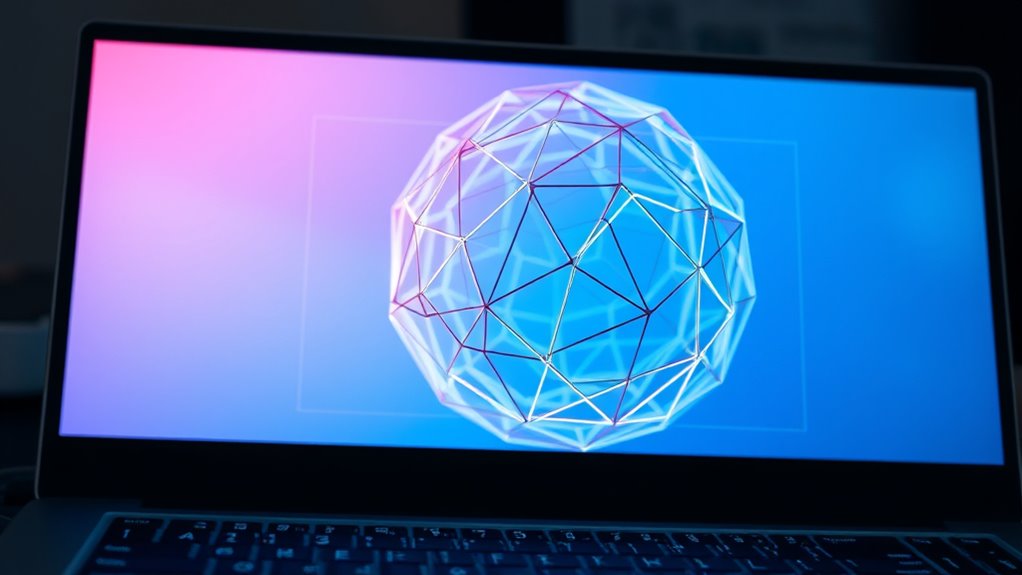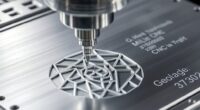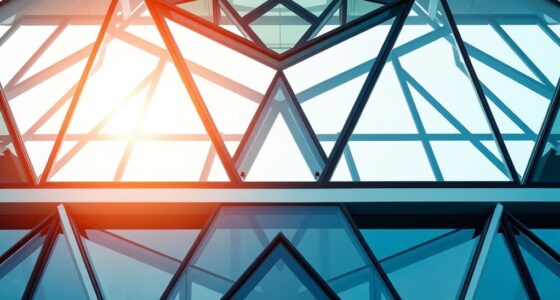In computer graphics, geometry starts with simple primitives like points, lines, and polygons, which form the building blocks of complex models. These shapes are manipulated through transformations and combined into meshes. During rendering, rasterization turns 3D models into pixels on your screen, while shading techniques add realism. Understanding how geometry flows from basic shapes to detailed visuals helps create immersive scenes. Keep exploring to discover how each step enhances digital images further.
Key Takeaways
- Fundamental primitives like points, lines, and polygons form the building blocks for modeling and rendering 3D scenes.
- Geometric transformations such as translation, rotation, and scaling manipulate object positions and shapes within virtual environments.
- The rendering pipeline converts 3D models into 2D images through processes like rasterization, using vertex processing and shading techniques.
- Surface detailing employs pixel shading, bump mapping, and procedural textures to enhance realism without altering geometry.
- Advanced geometric concepts support complex modeling, realistic virtual environments, collision detection, and interactive graphics applications.
Basic Geometric Primitives and Their Properties

Basic geometric primitives form the foundation of computer graphics by providing simple shapes that can be combined and manipulated to create complex scenes. These primitives include primitive types like points, lines, and polygons. Polygons are especially important because their properties—such as the number of sides, vertices, and angles—define their shape and appearance. Understanding polygon properties helps you control how surfaces are rendered and shaded. Primitive types serve as the building blocks for models, making it easier to construct detailed objects. By mastering these basic shapes, you can efficiently develop complex visuals and animations. Their simplicity allows for easy transformations, such as scaling, rotating, and translating, which are essential operations in computer graphics workflows. Recognizing geometric properties enhances your ability to accurately model and animate objects in digital environments.
3D Modeling and Mesh Construction

Have you ever wondered how complex 3D models are built from simple shapes? It all begins with modeling techniques like wireframe modeling, where you create a skeletal structure using lines and vertices. This method helps you visualize the model’s framework clearly. From there, you develop polygonal meshes—collections of polygons, typically triangles or quadrilaterals—that form the surface of your object. These meshes provide detailed control over shape and detail, allowing you to refine your model with precision. You can add or remove polygons to improve accuracy or optimize performance. Fiber-rich meshes are essential for supporting the detailed features of more complex models. Mesh construction is fundamental in computer graphics, enabling you to build anything from simple objects to intricate characters, all while maintaining a clear understanding of the underlying geometry.
Transformations and Geometric Operations

You’ll use transformation matrices to change object positions and shapes in your scene. Scaling and rotation help you modify size and orientation easily, while translation techniques move objects across the space. Mastering these operations is essential for creating dynamic and accurate computer graphics. Additionally, understanding the effects of juice detox can help you optimize health benefits during your projects involving visualizations of wellness trends.
Transformation Matrices
How do computer graphics manipulate objects in a scene? They rely on transformation matrices to perform coordinate transformation efficiently. These matrices enable you to apply operations like translation, rotation, and scaling through matrix multiplication, altering object positions and orientations seamlessly. Transformation matrices are essential because they provide a unified way to modify objects with a single operation.
| Transformation | Effect |
|---|---|
| Translation | Moves objects across the scene |
| Rotation | Spins objects around an axis |
| Scaling | Changes object size |
| Shearing | Slants objects in space |
Scaling and Rotation
Building on transformation matrices, scaling and rotation are fundamental operations that modify an object’s size and orientation within a scene. Scaling effects change an object’s dimensions uniformly or non-uniformly, achieved through scaling matrices that stretch or shrink the object along specific axes. Rotation matrices, on the other hand, enable you to turn objects around a point or axis, adjusting their orientation without altering size. When applying scaling, you modify the object’s proportions, while rotation matrices help you position objects precisely in space. These transformations are essential for creating realistic and dynamic scenes, allowing you to manipulate objects efficiently. By combining scaling and rotation, you can achieve complex geometric effects that enhance visual storytelling and scene composition. Understanding coordinate systems is crucial for accurately applying these transformations within a 3D environment.
Translation Techniques
Have you ever wondered how objects can be moved effortlessly within a scene? It all comes down to translation techniques, which rely on coordinate systems and translation algorithms. By shifting an object’s position along the x, y, and z axes, you can relocate it without altering its shape or size. You start by selecting a coordinate system, typically the world or local system, then apply a translation algorithm to calculate the new position. These algorithms use simple vector addition to update an object’s coordinates, making movement seamless and precise. Understanding how coordinate systems interact with translation operations allows you to manipulate objects efficiently, ensuring they move exactly as intended within your scene. This fundamental technique is essential for dynamic and realistic computer graphics, especially when considering how objects are placed within a Bedroom environment.
Rendering Pipelines and Rasterization

When you start exploring rendering pipelines, you’ll see how vertex processing transforms 3D models into screen-ready data. Rasterization then converts these processed vertices into pixels, creating the visual output. Finally, pixel shading techniques add color and detail, bringing the scene to life.
Vertex Processing Steps
Vertex processing is an essential stage in the rendering pipeline where raw geometric data is transformed into screen-ready coordinates. During this step, you perform vertex shading, which applies lighting and transformations, making the vertices appear realistic. You’ll access vertex data stored in a vertex buffer, ensuring efficient handling of geometric information. The process involves transforming vertex positions from object space to clip space, preparing them for rasterization. Vertex shading also allows you to modify attributes like color, texture coordinates, and normals. This stage is fundamental for shaping how your 3D models will ultimately appear on-screen. By accurately processing vertices, you set the foundation for smooth, realistic rendering, ensuring that the subsequent rasterization phase can accurately convert your transformed geometry into pixels. Additionally, understanding the role of color accuracy and how it impacts final image quality can help optimize your rendering results.
Rasterization Mechanics
Ever wonder how a 3D scene turns into the 2D image you see on screen? Rasterization mechanics handle this transformation by converting polygons into pixels. You’ll see how the rendering pipeline processes geometry, applying antialiasing techniques to smooth edges and reduce jagged lines. Depth buffering ensures correct visibility by tracking which surfaces are in front, preventing hidden surfaces from appearing. During rasterization, pixels are filled based on interpolated vertex data, and fragments are tested against depth buffers. This process balances speed and quality, allowing real-time rendering. Key aspects include:
- The role of antialiasing techniques in image clarity
- How depth buffering maintains proper object layering
- The rasterization process converting polygons into pixel data
Additionally, understanding the attention to detail of QA engineers helps improve the accuracy of rendering algorithms and visual outputs.
Pixel Shading Techniques
Pixel shading techniques are essential for adding realism and detail to computer-generated images by determining how surfaces appear under various lighting conditions. Procedural shading allows you to generate complex textures and patterns algorithmically, reducing reliance on static images. Bump mapping enhances surface detail by simulating small-scale bumps and dents, creating the illusion of depth without modifying geometry. These techniques are integrated into rendering pipelines, where shaders process pixel data to produce realistic effects. By applying procedural shading, you can create dynamic, intricate surfaces that respond to lighting dynamically. Bump mapping adds subtle surface variations, making objects look more textured and lifelike. Together, these techniques enable you to craft visually rich scenes that convincingly mimic real-world materials and lighting environments. Additionally, understanding the role of rendering pipelines in processing pixel data is crucial for implementing these shading techniques effectively.
Texture Mapping and Surface Detailing

Have you ever wondered how digital surfaces achieve realistic detail and depth? Texture mapping allows you to apply images or patterns onto 3D models, creating detailed surfaces without increasing polygon count. Techniques like procedural texturing generate complex patterns algorithmically, saving memory and enhancing realism. Bump mapping adds surface detail by simulating small bumps and dents, giving flat textures a more tactile feel. Understanding these methods helps you craft more convincing environments and characters.
- How procedural texturing creates intricate, seamless patterns
- Using bump mapping to enhance surface realism
- Combining texture mapping with surface detailing for depth
Pixel Processing and Shading Techniques
To create realistic and visually appealing images, understanding pixel processing and shading techniques is essential. You utilize antialiasing methods to smooth jagged edges and improve image quality, making scenes appear more natural. Shading techniques like Phong shading or flat shading help determine how light interacts with surfaces, adding depth and realism. Bump mapping is another powerful tool you use to simulate surface details without increasing geometry complexity, creating the illusion of bumps and dents on textures. These techniques work together during pixel processing to enhance visual fidelity, ensuring your rendered images look smooth, detailed, and lifelike. Mastering these methods allows you to produce high-quality graphics that captivate viewers and elevate your visual storytelling. Additionally, understanding how surface properties influence shading helps in achieving more convincing and dynamic visual effects.
The Role of Geometry in Modern Graphics Technologies

Geometry serves as the foundation of modern graphics technologies, enabling the creation of complex, realistic virtual environments. It underpins how shapes, surfaces, and structures are modeled and rendered. Parametric curves, for example, allow you to design smooth, flowing contours essential for animation and object modeling. Spatial algorithms help efficiently manage and manipulate large datasets, improving rendering speed and accuracy. You’ll also rely on geometric principles for collision detection, physics simulations, and lighting calculations. These tools and concepts work together to produce immersive experiences. Additionally, understanding cultural celebrations can inspire creative designs and thematic elements in virtual environments.
Frequently Asked Questions
How Does Computational Geometry Optimize Rendering Performance?
You can optimize rendering performance by using computational geometry techniques like mesh simplification and spatial partitioning. Mesh simplification reduces the complexity of models, making rendering faster without losing detail. Spatial partitioning divides scenes into manageable sections, speeding up rendering by focusing only on visible parts. These strategies minimize calculations, improve efficiency, and guarantee smoother graphics, making your rendering process more effective and responsive.
What Are the Challenges in Real-Time Geometric Calculations?
When tackling real-time geometric calculations, you face challenges like ensuring accurate collision detection without slowing down performance. Mesh simplification helps by reducing complexity, but it can compromise detail and precision. You need efficient algorithms that balance speed and accuracy, handle dynamic changes seamlessly, and optimize hardware resources. Overcoming these challenges allows you to create smooth, responsive graphics, enhancing user experience in gaming, simulations, and interactive applications.
How Does Geometry Influence Visual Effects Like Reflections?
Did you know that accurate light reflection calculations enhance realism in visuals by over 60%? Geometry plays a vital role here; surface curvature determines how light bounces, creating convincing reflections. When you understand the surface’s shape, you can simulate realistic reflections that match the environment. This means your graphics become more immersive, with reflections that respond naturally to surface details, making scenes feel truly lifelike and engaging.
What Advancements Are Shaping Future Geometric Modeling Techniques?
You’re exploring future geometric modeling advancements, focusing on parametric surfaces and topological analysis. These techniques enable you to create more detailed, flexible models, improving realism and efficiency. Innovations like adaptive algorithms and real-time processing help you develop complex shapes seamlessly. As technology evolves, you’ll find these methods shaping smarter, more dynamic graphics, pushing the boundaries of how digital worlds are built and experienced.
How Do Geometric Algorithms Handle Complex, Irregular Shapes?
You might imagine handling millions of tiny, irregular shapes every second. Geometric algorithms tackle complex, irregular shapes through techniques like mesh simplification, reducing detail while preserving essential features. Curve fitting also plays a key role, smoothly approximating intricate outlines. These methods enable computers to process and visualize complex forms efficiently, making detailed models manageable and realistic, even when shapes are highly irregular or intricate.
Conclusion
While mastering geometric principles might seem complex, understanding how polygons, meshes, and transformations work *unlocks* stunning visual possibilities. Don’t let the technical details discourage you—these fundamentals are the foundation for creating realistic, immersive graphics. With practice, you’ll see how geometry transforms simple shapes into vibrant scenes and lifelike textures. Embrace the challenge, and you’ll soon craft visuals that captivate and inspire. The world of computer graphics is waiting for your creative touch!









